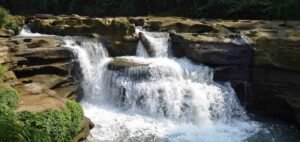Ashuganj’s Century-Old Rice Market Home / BOC Ghat sits about...
Read MoreMaheshkhali island: A Unique Fusion of Hill and Culture
Discover one of Bangladesh’s rising economic zones, only Hilly Island and it’s Beauty.
Maheshkhali island: A Unique Fusion of Hill and Culture
Among the most beautiful islands in Bangladesh to visit during leisure or vacation is Maheshkhali. The southwest sides of Maheshkhali are bordered by the Bay of Bengal.
On the east, the Maheshkhali Channel separates the island from the mainland Cox’s Bazar. Maheshkhali lies just across a 7-kilometer channel from Cox’s Bazar Sadar.
During low tide, a bridge made of boats is built over the mud for walking, which leads to the Maheshkhali jetty.
Life here follows the rhythm of the tides. Whether it’s fishing trawlers or passenger boats, the Maheshkhali jetty remains busy and lively throughout both high and low tides with the daily hustle of sea-dependent locals.
In the salty waters of the tide, a coastal green belt has formed, protecting the island from storms and tidal surges.

Unique Landscape of Maheshkhali
What sets Maheshkhali apart from all other islands in Bangladesh is its unique geological diversity. The formation of this island is credited to a massive earthquake.
Over 450 years ago, Maheshkhali was part of mainland Bangladesh. However, the powerful earthquake of 1569 separated it, transforming it into an island.
Since then, countless hills and small elevations have appeared across the island, especially along the eastern coast and the central region.
These hills are actually an extension of the Chittagong hill range, with heights ranging from 61 to 168 feet. Maheshkhali is the only island in Bangladesh where such hills exist.
At the base of these hills and uplands, there are approximately 5,300 hectares of flat, arable land.
The island itself, formed through a mix of plains, hills, and elevated terrain, spans an area of 362 square kilometers.
Adinath Temple and Rakhine Market


Among the many attractions in Maheshkhali, one of the most prominent is the Adinath Temple.
Visitors come from far and wide to see it, prompting local Rakhine weavers to set up colorful stalls displaying a variety of traditional handwoven products.
The main temple is located at the top of a hill. Every year, during the Hindu festival of Shiv Chaturdashi in the month of Phalgun, a grand fair known as the Adinath Mela(Fair) is held here.
The temple is dedicated to Lord Shiva, who is also known as Mahesh. It is believed that the name Maheshkhali is derived from this name.
Near Mainak Hill, a beautiful pagoda adorned with lion sculptures catches the eye. This Buddhist pagoda, a blend of architecture, sculpture, and fine art, is also one of the island’s main attractions.
Life of Maheshkhali Island
A large portion of Maheshkhali’s cultivable land is dedicated to betel leaf farming. The scientific name of this variety is Piper betle. The farmers who grow betel leaves are locally known as baroi.
With their care, the plants flourish in a delicate balance of light and shade. Betel leaves from different parts of Bangladesh have different flavors—but Maheshkhali’s betel is known for its naturally sweet taste.
Although Maheshkhali is an island, its large size earned it official recognition as an island in 1983. Life in this sea-surrounded region comes with constant companions—storms, tidal surges, and cyclones.
The island is divided into seven unions, consisting of 25 mouzas and 170 villages, with a total population of around 1 million.
Among the working population, 23% earn their livelihood from agriculture, making it a major source of income for the islanders.
Betel Leaves Of Maheshkhali

According to the Maheshkhali Upazila Agriculture Office, the island is home to around 8,000 betel leaf gardens spread over approximately 1,400 hectares of land. Nearly 13,000 farmers are involved in betel cultivation here.
Betel leaves from Bangladesh, including those from Maheshkhali, are exported to various countries around the world, including the Middle East, earning the nation valuable foreign currency.
Maheshkhali’s sweet betel leaf is not only a local favorite—it is also a cherished part of hospitality across Bangladesh.
The fame of Maheshkhali’s betel leaf has found its way into Bangladeshi songs, stories, and poetry. Today, “Maheshkhali’r Paan” has become more than just a crop—it is a legendary brand celebrated across the country.
Rakhine Community in Maheshkhali
Alongside the Bengali population, more than a thousand Rakhine families live in Maheshkhali. These Rakhines originally migrated from Arakan (now Rakhine State in Myanmar) around 250 years ago.
Belonging to the Mongoloid ethnic group, the Rakhines have distinct language, customs, clothing, and food habits.
Rakhine women spend most of their day weaving the thread on a spinning wheel called “rahi.” With creativity and generational knowledge, they craft colorful fabrics on traditional looms.
Their temples, called “Kyangs,” are built in Indo-Chinese architectural styles and reflect their spiritual and cultural identity.
The Buddha statues in the temple are made of different materials—some are brass, while others are adorned with gold.
For nature lovers, Maheshkhali’s casuarina forest (Jhāu Bon) is an ideal retreat. Beyond its scenic beauty, Maheshkhali is now recognized as Bangladesh’s largest energy hub.
Numerous local and international investors have already invested in the energy sector here.
As a result, in the coming years, Maheshkhali will not only be known for its natural charm but also for its growing industrial and economic significance in Bangladesh.
Bangladesh Army in the era of Bangladesh 2.0
Bangladesh Army in the era of Bangladesh 2.0 Home /...
Read MoreNafakhum Waterfall: Hidden Water Mystery
Nafakhum Waterfall: Hidden Water Mystery Home / The Chittagong Hill...
Read MoreGovernment Promotes China Investment In Bangladesh 2.0
Home / Government Promotes China Investment In Bangladesh 2.0 ...
Read More


